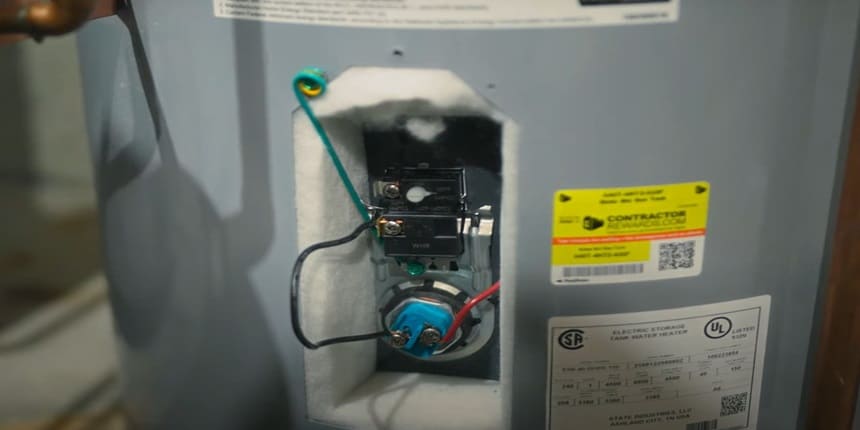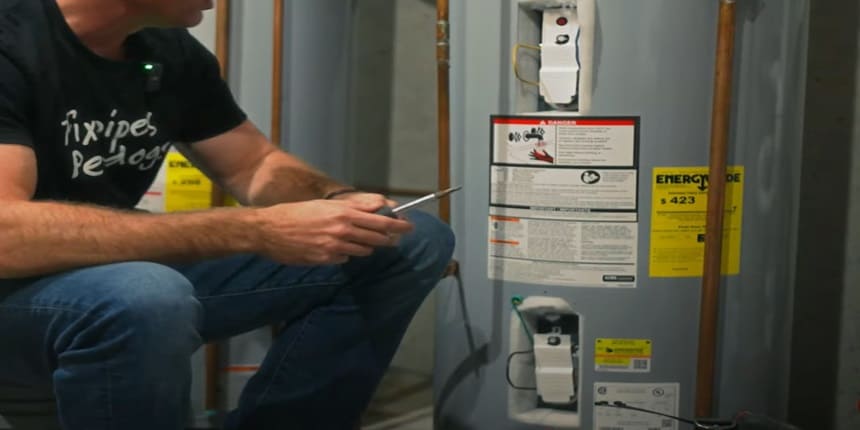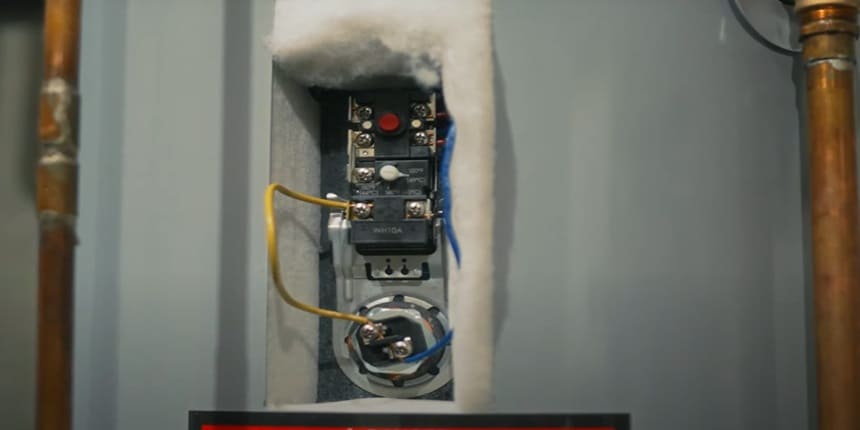Imagine stepping into a shower only to be greeted by water that’s either scalding hot or uncomfortably cold. Sound familiar?
Your electric hot water heater’s temperature settings might be to blame. Whether you’re looking to optimize comfort, conserve energy, or ensure the safety of your household, understanding how to properly adjust the top and bottom temperature settings of your heater is key.
This isn’t just about dialing in the right number; it’s about enhancing your daily routine and giving yourself peace of mind. Curious to learn how to strike the perfect balance with your water temperature?
Read on, and discover the simple steps that can transform your hot water experience from frustrating to flawless.
Ideal Temperature Range for electric hot water heater

The ideal temperature for water heaters is 120 degrees Fahrenheit. This setting saves energy and prevents scalding. Kids and elderly people are safer. Lower temperatures can cause bacteria growth.
Higher temperatures can waste energy and money. Always check both the top and bottom settings on your heater. These settings should match for consistent heating. If unsure, ask an expert for help.
Water at 140 degrees can scald in seconds. At 120 degrees, it takes minutes. The energy savings at 120 degrees is significant. A small change can make a big difference. Check your heater regularly. Adjust if needed for safety and savings.
Factors Influencing hot water temp settings
Different homes need different temperatures. Families with young kids may prefer lower settings. This helps avoid burns from hot water. Adults might want warmer water. They enjoy hot showers. Consider dishwashing needs too. Some people need hot water for cleaning dishes.
Saving energy is important. Lower settings use less power. This helps save money. Higher temperatures mean more energy use. Some heaters have smart features. They adjust settings to save power. Efficient heaters are good for the environment.
Safety is key with heaters. Very hot water can cause burns. Lower temperatures reduce this risk. Older people and kids need extra care. Some heaters have safety locks. These prevent accidental changes. Settings should keep everyone safe.
Adjusting Your electric hot water heater temperature settings

Find the thermostat on your water heater. It is usually behind a panel. Turn off the power before starting. Safety is very important. Use a screwdriver to open the panel.
Look for two dials inside. These are the thermostats. One is at the top. The other is at the bottom. Each controls part of the heater. Keep track of the original settings. This helps in case you need to reset.
Start with the top thermostat. Use a flathead screwdriver. Turn the dial to set the temperature. Do the same for the bottom thermostat.
Check the recommended temperature. 120°F is common. It saves energy and prevents burns. Close the panel after adjustments. Turn on the power. Let the water heat for a while. Test the water temperature. Adjust again if needed. Always ensure safety first.
Balancing Comfort And Efficiency temperature difference in water heater
Different seasons need different water heater settings. In winter, you might like warmer water. This helps stay cozy and warm. In summer, cooler water may feel refreshing. Adjust the settings to match the season.
Saving energy is also important. Lower settings can help save electricity. This can make your bills lower. Always think about safety. Water too hot can cause burns. So, balance warmth and safety in every season.
Larger families need more hot water. More showers, more dishes, more clothes to wash. A higher temperature can help meet these needs. But, be careful. Hotter water uses more energy. It can also increase your bills. Teach everyone about water use.
Shorter showers, less waste. Find a balance that works for everyone. Safety first, then comfort.
Safety Measures hot water heater thermostat temperature
Setting the right water temperature is important. Hot water can cause burns. Keep the heater temperature below 120°F.
This reduces the risk of scalding. Check the heater settings regularly. Ensure the temperature stays safe. Teach family members about safe water use. Never let children adjust the heater. Install anti-scald devices for added safety. These devices control water temperature.
Children are curious and playful. Educate kids about hot water dangers. Tell them not to touch the heater. Always supervise bath time for young children. Test the water before they enter the bath. Use faucets with temperature control.
This helps keep bath water safe. Keep the heater area closed. Prevents children from playing near it. Regularly inspect the heater for damage. Make sure all parts work well.
Troubleshooting Common Issues for Electric water heater thermostat settings

Inconsistent hot water can be frustrating. Check the thermostat settings first. Both top and bottom thermostats should match. If not, this can cause uneven heating.
Sediment build-up inside the tank might also be a reason. This reduces efficiency. Draining the tank can help. Ensure all heating elements are working.
A faulty element may cause temperature changes. Regular maintenance is key for consistent water temperature.
High energy bills can be surprising. Improper thermostat settings might be the cause. Setting the temperature too high increases energy use.
Insulation problems can lead to heat loss. Check if the tank has proper insulation. Old heating elements may consume more power. Replacing them can save energy. Regular inspections help in maintaining efficiency. Always monitor energy usage closely.
Regular Maintenance Tips water heater thermostat same temp
Flushing the tank keeps your water heater working well. It removes sediment that settles at the bottom. Start by turning off the heater. Connect a hose to the drain valve. Let the water flow out. This clears dirt and keeps the heater clean. Flush the tank every six months for best results. It helps the heater last longer.
Check for leaks around the tank often. Look for wet spots on the floor. Leaks can cause damage. A small leak can grow quickly. Tighten loose connections if you see leaks. Call a professional if the leak does not stop. Regular checks help prevent big problems. Keeping the heater dry ensures it works well.
When To Call A Professional
Adjusting electric hot water heater temperature can be tricky. Call a professional if settings are confusing or inconsistent. Safety and efficiency depend on correct adjustments.
Recognizing Faulty Components
Hot water heaters have many small parts. These parts can break or wear out. Signs of faulty parts include unusual noises and no hot water. Leaking water is also a sign of problems. Broken thermostats can cause water to be too hot or too cold. Corroded wires might make the heater unsafe. Call a professional if you see these signs.
Regular Inspections
Regular checks help keep your heater working well. Check for rust on the tank. Look for any signs of leaks. Listen for strange noises from the heater. Keep an eye on the heater’s temperature settings. Check wires for damage. Inspections can prevent bigger problems later. A professional inspection is safe and thorough.
What Temperature Should Electric Hot Water Heater Be Set At?
Set your electric hot water heater to 120°F (49°C) for safety and efficiency.
This temperature prevents scalding and conserves energy. Most manufacturers recommend this setting to balance comfort and cost-effectiveness.
Always check your heater’s manual for specific guidelines and maintenance tips.
Why Are There Two Thermostats On A Hot Water Heater?
Two thermostats regulate water temperature in a hot water heater. The upper thermostat controls the upper element, heating water first.
The lower thermostat manages the bottom element, ensuring consistent temperature. This dual system ensures efficient operation and balanced heat distribution throughout the tank, enhancing energy efficiency and performance.
What Is The Difference Between The Upper And Lower Elements Of A Water Heater?
The upper element heats water in the top part of the tank, while the lower element heats the bottom. Together, they ensure consistent hot water supply by alternating heating cycles.
This setup allows efficient energy use and quick recovery times.
What Temperature Is The B Setting On A Water Heater?
The “B” setting on a water heater typically corresponds to around 140°F (60°C). This ensures hot water is readily available while reducing the risk of scalding.
Always check the manufacturer’s guidelines for precise temperature settings and safety instructions. Regularly monitor your heater to maintain optimal performance.
Conclusion
Setting the right temperature on your electric hot water heater matters. It impacts energy use and safety. Keep both top and bottom settings balanced. Aim for around 120°F to conserve energy and reduce scalding risks. Regularly check your settings for efficiency.
Adjustments can lead to better performance and savings. Consult your heater’s manual for guidance. Proper settings enhance heater lifespan and functionality. Remember, these small changes make a big difference. Enjoy hot water safely and efficiently every day. Keep an eye on your heater’s performance.
Good maintenance ensures a reliable hot water supply.

